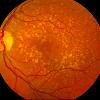

- » FDA clears first-of-a-kind telescope implanted into the eye to counter a blindness of aging
- » Study: Stem cell transplants hold promise for blindness caused by chemical burns
- » Visually impaired skier McKeever to be first winter athlete in both Olympics, Paralympics
- » Visually impaired skier Brian McKeever of Canada is a step closer to gaining an Olympic spot
Description A fundus photo showing intermediate age-related macular degeneration. Tags: Macular Degeneration View |
Topics: Health Tags: Macular Degeneration View |
Topics: Health Tags: Macular Degeneration View |
|||||||||
Age related macular degeneration is a medical condition which usually affects older adults that results in a loss of vision in the center of the visual field (the macula) because of damage to the retina. It occurs in ?dry? and ?wet? forms. It is a major cause of visual impairment in older adults (>50 years). Macular degeneration can make it difficult or impossible to read or recognize faces, although enough peripheral vision remains to allow other activities of daily life.
The inner layer of the eye is the retina, which contains nerves that communicate sight; behind the retina is the choroid, which contains the blood supply to the macula (the central part of the retina). In the dry (nonexudative) form, cellular debris called drusen accumulate between the retina and the choroid, and the retina can become detached. In the wet (exudative) form, which is more severe, blood vessels grow up from the choroid behind the retina, and the retina can also become detached. It can be treated with laser coagulation, and with medication that stops and sometimes reverses the growth of blood vessels.
Although some macular dystrophies affecting younger individuals are sometimes referred to as macular degeneration, the term generally refers to age-related macular degeneration (AMD or ARMD).
Age-related macular degeneration begins with characteristic yellow deposits in the macula (central area of the retina, which provides detailed central vision, called the fovea) called drusen between the retinal pigment epithelium and the underlying choroid. Most people with these early changes (referred to as age-related maculopathy) have good vision. People with drusen can go on to develop advanced AMD. The risk is considerably higher when the drusen are large and numerous and associated with disturbance in the pigmented cell layer under the macula. Recent research suggests that large and soft drusen are related to elevated cholesterol deposits and may respond to cholesterol-lowering agents.
Icd10: ICD10H353h30
Icd9: ICD9362.50
Diseasesdb: 11948
Emedicinesubj: article
Emedicinetopic: 1223154
Medlineplus: 001000
Meshid: D008268 File:Human eye cross-sectional view grayscale.pngrightthumbHuman eye cross-sectional view



